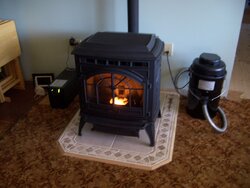Hopefully you guys can help me out. I have a 2 month old freestanding Quadrafire Castile. It seems that our house should be warmer. Or at least warm. A meat thermometer inserted into a heat tube only got up to 170 degrees. The exiting air is warm, I can hold my hands right in front of it all day. The vent pipe is very, very hot- too hot to touch. Running on medium 24/7, it never gets over 63 inside. Please help me before winter really kicks in!
Here’s the details-
*1200 sf house, everything is closed off except for living room, dining room, kitchen, and bathroom. So maybe 800 sf to heat. The stove is rated for 1800 sf.
*I installed this myself, the stealer wanted $1700. Parts cost me around $400.
*It is vented into a 15 foot tall chimney, 6”x8” clay liner, no metal pipe inserted.
*Had a chimney sweep clean and inspect the chimney. No problems.
*It is very clean, I took it apart and cleaned thoroughly a week ago, no change.
*No outside air kit, the house is old and leaky.
*The feed rate is set almost to high. I've played around with all settings.
*The flames are good and tall and yellow and lively, almost too bright to look at.
*Burning a bag a day.
*The ashpot gets about 1-2 inches of hard clinkers in it every day, I have to chop them up to get them to dump out.
*Hooked up to the thermostat that came with the stove, set to 70, lowest anticipator #.
*Burning PA Pellets, can’t find anything else to try out until “next year”.
*SE Vermont, it’s been around 40 days, 25 nights. I dread really cold winter!
I’ve attached a pic so you can see the vent pipe set up, etc.
Any ideas out there? My thought is that the heat is going out the chimney rather than into the house. What would cause this? We are having troubles with the dealer, who is not factory authorized, and pizzed that we didn’t pay them to install it, so not much help there.
Thanks a ton! So thanks $330, if I could buy a ton around here. But that’s another post.
Barrett

Here’s the details-
*1200 sf house, everything is closed off except for living room, dining room, kitchen, and bathroom. So maybe 800 sf to heat. The stove is rated for 1800 sf.
*I installed this myself, the stealer wanted $1700. Parts cost me around $400.
*It is vented into a 15 foot tall chimney, 6”x8” clay liner, no metal pipe inserted.
*Had a chimney sweep clean and inspect the chimney. No problems.
*It is very clean, I took it apart and cleaned thoroughly a week ago, no change.
*No outside air kit, the house is old and leaky.
*The feed rate is set almost to high. I've played around with all settings.
*The flames are good and tall and yellow and lively, almost too bright to look at.
*Burning a bag a day.
*The ashpot gets about 1-2 inches of hard clinkers in it every day, I have to chop them up to get them to dump out.
*Hooked up to the thermostat that came with the stove, set to 70, lowest anticipator #.
*Burning PA Pellets, can’t find anything else to try out until “next year”.
*SE Vermont, it’s been around 40 days, 25 nights. I dread really cold winter!
I’ve attached a pic so you can see the vent pipe set up, etc.
Any ideas out there? My thought is that the heat is going out the chimney rather than into the house. What would cause this? We are having troubles with the dealer, who is not factory authorized, and pizzed that we didn’t pay them to install it, so not much help there.
Thanks a ton! So thanks $330, if I could buy a ton around here. But that’s another post.
Barrett


 . Way to many fines, pellets crumble in your hand. They went and got PA junk (were cheaper) when the dry creek plant is 10 minutes away go figure (10 bucks more per ton). The PA pellets do not even look like normal pellets they are Pouris. I would go out and get a couple bags of another brand and try them before doing anything else like adjusting the stove setting and rule out the pellets as being the problem. This is the best and simplest way to start in MHO.
. Way to many fines, pellets crumble in your hand. They went and got PA junk (were cheaper) when the dry creek plant is 10 minutes away go figure (10 bucks more per ton). The PA pellets do not even look like normal pellets they are Pouris. I would go out and get a couple bags of another brand and try them before doing anything else like adjusting the stove setting and rule out the pellets as being the problem. This is the best and simplest way to start in MHO.